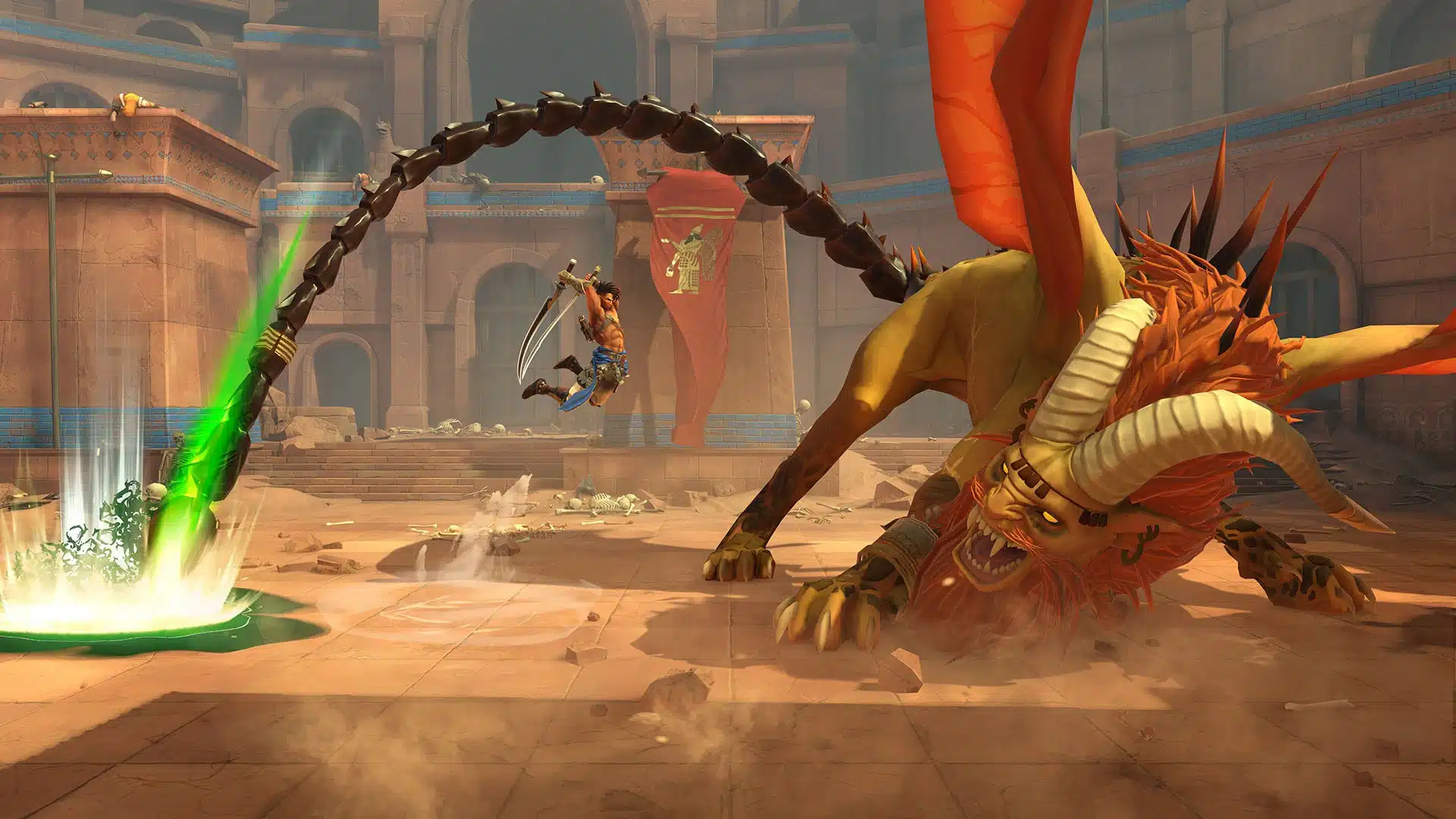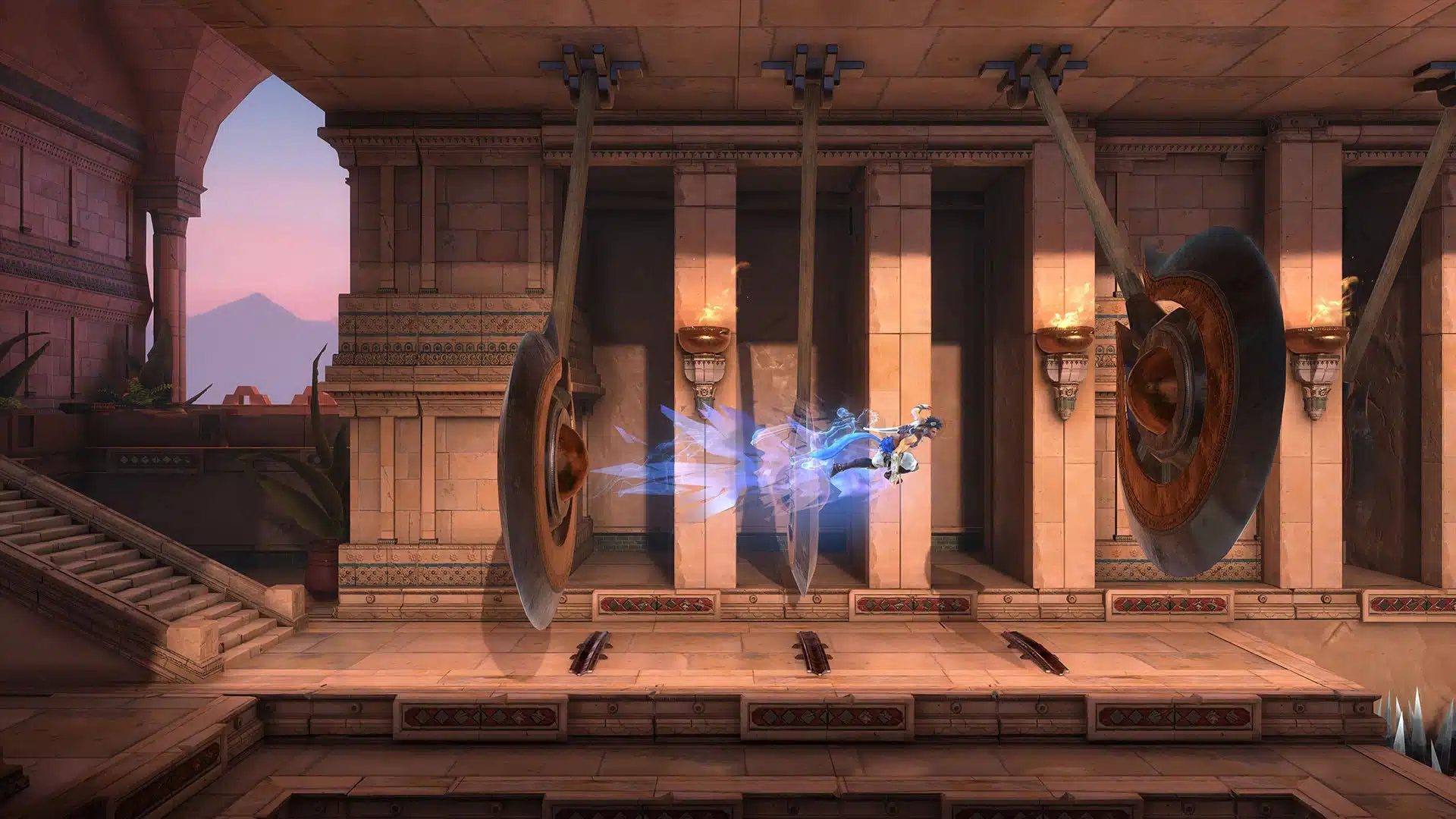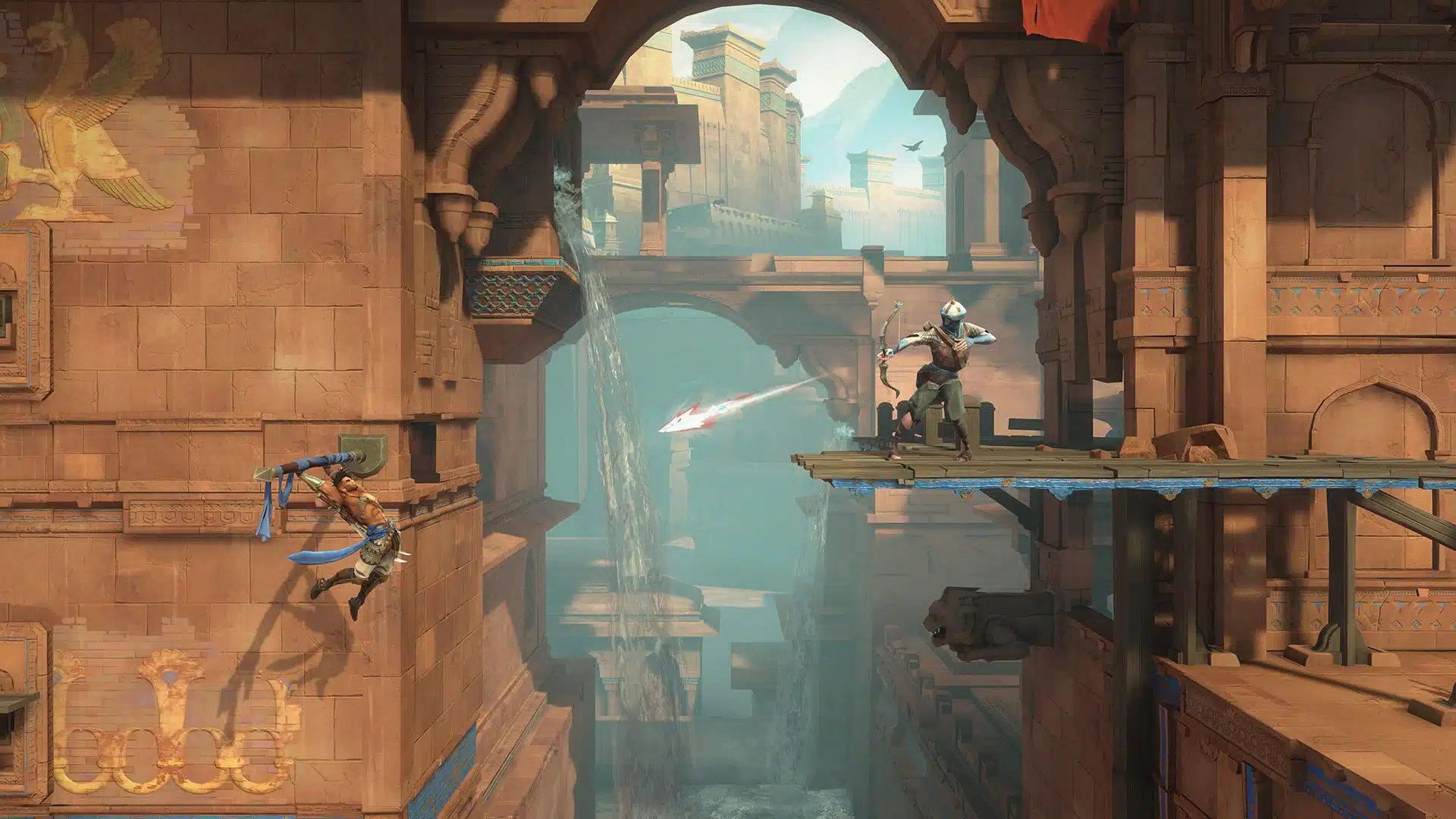The Prince of Persia franchise has featured periods of prolific releases and others of droughts, with the last decade falling into the latter category. With the previously announced delayed Prince of Persia: The Sands of Time remake still a no-show until who knows when, many had assumed that was a death kneel for the series for a while. That was until the announcement of a brand new entry in the franchise that would jump into the Metroidvania genre for the first time with Prince of Persia: The Lost Crown.
A Whole New World
Unlike the majority of the Prince of Persia series, you do not play as a titular prince here, but rather as a member of a group of elite warriors known as the Immortals where you play as Sargon. This group has served the current Queen Thormyris and the game starts with them coming off another major victory to protect Persia. Things quickly go sideways, however, when Prince Ghassan is captured by Sargon’s mentor and friend Anahita, Sargon and the Immortals must set off to save him and end up being enveloped in the mysterious Mount Qaf which has suffered temporal anomalies that make past meet present and more. The story itself is quite enjoyable with betrayals and surprises along the way, so I won’t spoil any further on the events of the game so you can best experience it for yourself.
The way that the game starts, you may think that you will have the opportunity to switch to some of the other Immortals or have team-ups with them throughout, but that is not the case. Instead, the majority of your experience in Prince of Persia: The Lost Crown is a solo experience outside of run-ins with these characters. There are also some other recurring characters you’ll come across in the story like a mysterious old man and a lost young boy, as well as some others, but most of the time you are exploring Mount Qaf alone.
Sargon’s goal at the start is to find Prince Ghassan and must travel across what starts as an empty map. While making your way along your main quest, activating Wak-Wak trees that you come across serve as the game’s save stations and equipment management locations. You will also respawn back at the last Wak-Wak tree you interacted with upon death as well. While it doesn’t come into play until a little later, there are also fast travel altars next to some of the Wak-Wak trees that allow you to quickly make your way across the map.
Very early in the game, you will reach an area known as The Haven, which serves as sort of your main hub in the game that falls near the center of the map. In this area, you can speak to the Shopkeeper to buy items such as Amulets, extra Healing Potions, and more. Then you can go to the Blacksmith Kaheva to either purchase a few items or upgrade your weapons, arrows, or amulets that you have available. All of these use the time crystal currency that you find in the game as well as mixing in a few other collectibles for higher-level upgrades. Lastly, you have one of the members of the Immortals in Artaban to train with once you obtain new abilities to help improve your skills and also earn some extra time crystals along the way.
Sargon not only has his trusty dual blades to use in battle but also acquires a bow and chakram that come in handy quite often. The dual blades are going to be your bread and butter though, as you are doling out damage to the enemy or using them to parry enemy attacks. Incoming enemy attacks can be handled in a few different ways, including dodging outright if possible. If the attack has no color to it, you can block or parry it by pressing block at just the right time. If the attack is yellow, parrying the attack will counter animation that often kills the enemy or at least does major damage. Red attacks are the ones you want to always dodge, as they are not able to be blocked or parried and can leave you vulnerable if you try to do either. The game has very smooth controls that give you complete control most of the time, but this parry system is not a perfect science though, so do be prepared for some moments of frustration along the way.

Prince of Persia: The Lost Crown features plenty of boss battles during your journey that will test your skills and reaction times. Some of these are more difficult than others, but you can almost always figure out some sort of pattern and use that to your advantage. I was really impressed by the variety in the boss battles, as they all felt very unique from one another and often pushed you to your limits. It was also very much appreciated that the game allows you to just retry the boss fight if you die rather than respawning at the last Wak-Wak tree you interacted with as seen otherwise. The balance of the appearance of boss fights did feel a little off in the game though, as there were only a few early on and then I ended up with a gauntlet of three big boss fights almost in a row later on. Perhaps that is just dependent on the order of how you tackle the map in the game, but it did feel a bit jarring nonetheless in my playthrough.
Sargon also has 10 different Athra Surges that can be unlocked to use in battle, each of which offers special abilities to use in battle. Sargon can equip two different Athra Surges at a time, with them being able to be activated based on the Athra gauge level. These abilities can either be level one, two, or three, which requires the use of one, two, or three bars of the Athra gauge respectively. The Surges each have different cooldown times as well, which makes the choice of which two to select all the more important. My personal two favorites were the level 1 Verethragna’s Surge and the level 3 Bahamut’s Rage, as they seemed to work well together time-wise, but the nice thing here is that it’s completely up to you on how you want to set them.
There are also 38 Amulets that you can collect in the game and equip on Sargon depending on how many open slots you have. You start the game with only three Amulet slots, but can find extra slots for a total of 12. However, this does not mean you can equip 12 different Amulets, as they range from taking up anywhere from just one to up to three slots each. Some of these can be incredibly helpful though, such as increasing health, the rate of Athra gauge building by parrying, or adding fire to your arrows. Going to Kaheva to upgrade these to their highest level can take Sargon to the next level as well.
Pretty much every Metroidvania has numerous abilities that unlock previously inaccessible locations in the game and Prince of Persia: The Lost Crown is no different. These are done via Time Powers that you find in the game, typically after defeating a boss or completing a main story quest. For any veteran of the genre, you knew going through the game that you’d end up getting later abilities like a double jump or something to get to higher areas and that is exactly what happens, in addition to several game-unique abilities like the Shadow of the Simurgh ability that lets you clone yourself and then quickly teleport back to the clone instantly or a Dimensional Claw that lets you grab objects like explosives to store and then use at a later time. I greatly appreciated the strategic manner in which these various abilities were used in the game, especially to solve certain puzzles.
Something very innovative found in this game is the introduction of what are known as Memory Shards. By pressing down on the d-pad at any time, you can take a snapshot of the screen and it will place that screenshot on your map with an icon showing that the image was taken. This is designed for you to take when you get to an area that you want to remember to come back to, either because you got stuck on a puzzle or did not have the ability required to continue. You do have a limited number of these Memory Shards to use, though you can acquire more in the game in a few areas. This is a fantastic addition to the genre that more games should take note of and include in the future.
Prince of Persia: The Lost Crown’s map is split into more than 10 different environments that usually feature different enemy types for you to face. Like all Metroidvanias, you will find yourself traveling back and forth between different areas quite often so it is very nice to have differing locales and enemies to really help each area set itself apart from one another. Some locations are obviously going to be more frustrating than others, such as the poison-filled Depths, but there is no single area in the game that felt poorly designed or out of place.
Not only will you be completing the main quests across Mount Qaf, but you can also pick up and complete an array of side quests from NPCs that you meet. Purchasing a map from a character named Fariba in each section can help here with not only completing side quests, but also when trying to hunt for all of the other collectibles in the game including what are known as Xerses coins.

Traversing the world in Prince of Persia: The Lost Crown is very satisfying as the game throws in some very challenging platforming sections that typically reward you with a treasure chest or the aforementioned Xerses coin. For the Xerses coin sections, you usually have to make your way through a difficult platforming section dodging “one-hit kill” obstacles and grabbing the coin before returning back the way you came and touching solid ground again to actually earn the coin. For those looking for excellent platforming sections, these deliver in spades even if it may take you a number of tries to master them. The good thing is that the “one-hit kill” obstacles don’t actually kill you, but rather just return you to the beginning of the platforming challenge and reduce your overall health a bit. This allows you to keep trying until you master the path, which was very fulfilling while playing through the game.
For the most part, there are rarely any points in the game where you have absolutely no idea where to go or what to do like some games in this genre. You will always have one main quest active that has an objective for what you need to do, but you will still have to do some exploring to complete those quests. Some quests like finding the Celestial Guardians are clearly marked on your map, though still require some thought on how to make it to said locations. You can always visit Fariba in the game’s hub area to get a hint for a price as well. For those that really struggle with finding their way in games like this, the game does offer a Guided mode that can be activated from the start or from the pause menu that displays the location of the next objective while also marking any available or blocked paths. This is something I chose to avoid using during my playthrough, but it’s a great feature to make the game more accessible.
The game also offers four set difficulty levels to choose from, while also letting you adjust sliders to your liking in categories like Enemy Damage, Parry Difficulty, and more to allow for numerous combinations. This can also be adjusted after starting, so you can feel free to go with a higher difficulty if you would like without the fear of getting stuck and not being able to bump it back. My playthrough was on the equivalent of a normal difficulty and I thought the difficulty level was very fair throughout while also still offering plenty of challenge.

Long load times in a Metroidvania game can almost ruin a good game since you will be constantly moving between areas, but Prince of Persia: The Lost Crown is very efficient with its load times when playing on PS5 at least. Going between screens takes not more than a second or two and even fast traveling is snappy as well. This makes it so easy to zip from one area of the map to another, which is vital when getting new abilities and having to backtrack to clean up past areas that were previously inaccessible.
The game is not without some bugs here and there, though they aren’t that often and usually just require a quick restart. One example was clipping through a wall when dashing and having to go back to the main menu and restart my save. Thankfully, I had just saved less than a minute prior so it was not a major issue, but this could have been if it had been a while since the last save spot. The weirdest one though came after beating the game and loading my save file again to clear up many of the extras, as the camera was instantly zoomed in way too far. I thought this was just something for the final area, but when I fast-traveled to another location, the game completely messed up and got stuck behind objects. Going back to the main menu didn’t even help here either, but force-closing the game and restarting it did. The good news is that these issues were very few and far between and they do not hinder the overall experience at all.
Verdict
Prince of Persia: The Lost Crown may not have had the strongest response from fans upon its initial announcement, but Ubisoft really knocked it out of the ballpark with this one in the end. Coming in at about the 20 to 25-hour mark for a well-explored playthrough felt just about right for this type of game to avoid overstaying its welcome. Taking Prince of Persia and mixing it with the Metroidvania genre was a brilliant move, as the gameplay and abilities from the series mesh very well with this style, and it makes me hope this is only the beginning of this franchise’s foray into this new direction and is not just a one-off experience.
Score: 9/10
Pros:
- Fun combat with lots of options
- Useful Time Powers
- Unique from one another boss fights
- Difficult, but well-designed platforming challenges
- Does not overstay its welcome
Cons:
- Parry timing can sometimes get frustrating
- Bugs can sometimes force you to reset the game
Prince of Persia: The Lost Crown was review code provided by the publisher. You can read MP1st’s review and scoring policy right here.


Suck that Ubisoft tit. Make sure not to give honest reviews. You’d hate to lose your review copy privileges after all.